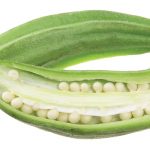
Something decorative and delicious (and so very good for you)
By Jan Leitschuh
It’s not too late to plant sweet potatoes.
I know, right?
You’ve got June harvests of summer squash, garden cabbage, cucumber, zucchini and the earliest blueberries and sweet corn on the brain — not sweet potatoes. You’ve harvested your spring-sown sugar snap peas, your kales and lettuces, your spinach and chards, your asparagus, dill, chives and green garlics. You have the tomatoes staked out in the garden, the first clusters already hinting at ripening next week, or the next. The peppers are promising. The okra went in the ground last month.
You could try planting sweet potatoes now. The vines can be quite decorative in a planter. And 150 days from now, in October, what will you harvest that will fill your bellies with a sweet, satisfying bulk, that will form the basis for a healthy, seasonal fall meal? Your area farmers began in May. But since you are not counting on sweet potatoes to pay the taxes and mortgage on your farm, you can begin today if the fancy strikes you.
Why not grow them in planters on your deck, taking advantage of the pleasant, cascading streamers of foliage? Come frost, you could just tip your planter over and harvest the fat tubers — decorative planter in summer, sweet potato ragout in fall. Don’t be confused by “sweet potato vines.” The white tuber ornamental sweet potato sold in garden centers is different from its orange-fleshed vegetable cousin, selected for foliage, not flavor.
Whether you use a planter or not, we live upon some of the best sweet potato ground in the world. The light, sandy loams of this area favor the production of sweet potatoes. The tubers expand readily in the light soils, producing good harvests.
In fact, North Carolina leads the nation in sweet potato production, growing over 45 percent of the U.S. supply. It’s our N.C. state vegetable — for those keeping score at home — thanks to some fourth-graders who suggested it to the General Assembly in 1995.
Some call it a superfood, with its readily available forms of Vitamin A and C, and their generous potassium and B6 content. It is lower on the glycemic index than regular potatoes. Its plant chemicals help support your skin, fight cancer and cholesterol levels. I call it the world’s easiest side dish. Several times a week, my husband and I rinse off a tuber, slit the side, wrap it in a paper towel and microwave for a few minutes until soft. Simply open and top with butter, coconut oil, applesauce, salsa or your favorite sweet or savory. Bam! One of the “5 A Day for Better Health” knocked down in the time it takes to check your phone.
That’s ignoring all the good things like sweet potato fries, sweet potato bread, sweet potato stew, sweet potato pie, sweet potato chips, sweet potato noodle kugel, maple-pecan sweet potato mashes and so much more.
But this is summer, and we have summer things on our minds. So let’s return to the growing:
The sweet potatoes you find in stores will likely be Covingtons (developed in N.C.) or Beauregard, perhaps a Jewel or a Ruby. A sweet potato starts as a simple sprout.
Do you remember suspending a sweet potato in a jar with toothpicks as a child? With half the sweet potato covered with water, and placed in the sunshine, it will produce several large leafy upwellings. In a month or so, that suspended sweet potato will have produced slim vines of 8 to 10 inches. Organic sweet potatoes are often best for this, since they have not been treated with a sprout retardant for long shelf life. My grandmother used to tuck one in a jar just for the pleasure of seeing that long vine grow and trail up her kitchen window.
Perhaps you have some older, unused sweet potatoes already beginning to sprout on their own. By all means, help them along. You can bury tubers halfway in a moist, warm bed of sand, lying on their side, to grow more sprouts. Local producers like to form neat, raised planting beds, prepping the soil with, say, an 8-8-8 fertilizer and adequate lime to make a neutral or slightly acidic soil.
I take my chances with a well-aged compost and lightly dig into a loose soil.
It seems impossible, but leafy sweet potato sprouts are tough, imbued with a strong will to take root and grow. As long as the soil is moist and warm, your sprouts will take root. If you grow your own on tubers, give them a twist at planting time to remove them from the parent sweet potato. Plant sprouts 8 to 10 inches apart, and water them in well. Keep your beds (or your planter) well watered until the sprouts begin to root, never letting them dry out that first 30 days.
In about a month, the shallow, expanding roots will demand another feeding. Side dress again with a little fertilizer or aged compost. Keep an eye on weeds that sprout among the expanding foliage. In time, the sweet potato’s leaves will cover the ground. I like to use simple garden scissors, weeding by snipping off the offender, not disturbing the shallow roots one bit. Keep up the watering and gentle fertilizing but be warned — deer love to nibble the tender sweet potato leaves. (Maybe a vote for a planter there?) Perhaps the third week in October or so, the first killing frost will come to the area and blacken the vines. It’s harvest time!
Either tip over your planter onto a tarp and pick out your tubers, or dig gently into the ground around your plants, exposing the crowns and following the roots downward to reveal your treasures. If you started early enough there will be big ones, and lots of small ones. Children, especially, love this part. If you carelessly stick a fork through a root, don’t be overly alarmed, they have the ability to form a skin over an injured area.
Remove your sweet potatoes from the field so that they are not exposed to the blazing fall sun. You’ll want to cure yours for the sweetest taste. Do this by spreading them out on newspapers in a warm dry area, airy, not exposed to direct sun. Your garage or shed or basement might just do the trick. Some of the starches will convert to that delicious sweet potato sweetness.
Some people wash their tubers off with a garden hose in the backyard. While that is satisfying — revealing the horde, in all its glory — it also starts the clock ticking on the possibility of rot. In our sandy soils, better to brush them off lightly, let them cure, then brush with a whisk for more cleaning. Commercial operations grade them, send them through a wash bath, then dip them in a fungicide to prevent rot. One of the advantages of homegrown is controlling exactly what chemicals go into and onto your food.
Store them in a cool, but not cold, place. Fifty-five degrees is about perfect. Place them in a paper-lined box, and put paper between the layers to better store your homegrown sweets. Rinse thoroughly just before baking. You’ll have sweet potatoes until Christmas, maybe longer if you took care during the curing and storing process. Or if you haven’t eaten them all up first. PS
Jan Leitschuh is a local gardener, avid eater of fresh produce and co-founder of the Sandhills Farm to Table Cooperative.





